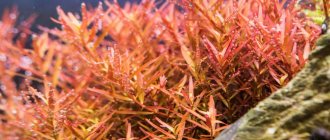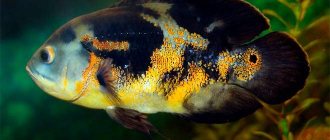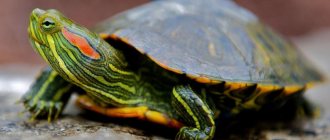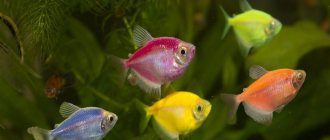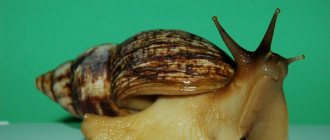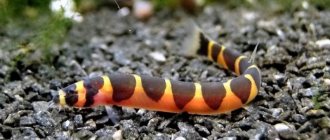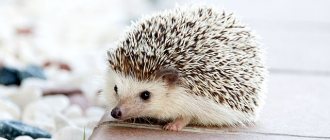- Exotic pets
The exotic iguana lizard looks impressive and beautiful, especially for our cold latitudes, but the desire to acquire such a pet often ends at the planning stage of arranging conditions for the reptile. Many people are concerned about how to care for an iguana at home, because this animal is accustomed to the hot and humid climate of Central and South America. Moreover, the question of a specific diet also remains open, since providing proper nutrition to a tropical lizard is not so simple, and the question of what to feed an iguana at home is quite acute. In this article we will try to answer most of the questions about this animal, as well as help you choose a healthy iguana as a pet.
How to choose an iguana?
First of all, you need to remember that iguanas are only born in May and June. For this reason, if you want to become the owner of a 2-month-old pet, it is best to go to the store at the end of summer. You cannot count on the fact that a 2-month-old iguana can appear in January, since this is contrary to natural laws.
Sellers cannot correctly determine the gender of a pet. A domestic iguana will certainly delight you with its presence, but it is advisable to understand that the correct sex will only be determined during puberty of the pet, so you will have to wait another year and a half for this wonderful moment. Professionals can answer the question regarding gender at 7–8 months by conducting special tests, but the answer cannot be provided earlier.
So, what is the best way to choose an iguana to ensure a worthy purchase?
- It is imperative to examine your pet's mouth. It is best to take the fry with your right hand, and then slightly pull the edge of the throat fold with your left hand. A light pink mouth will indicate good health, and the tongue should be reddish. Warning is caused by a very light or grayish-lilac tint of the oral cavity, since such changes indicate a lack of calcium that needs to be replenished. Other colors indicate serious illness.
- It is mandatory to carefully examine the limbs and fingers, which cannot be swollen or swollen. Lack of claws is remediable, as claws can gradually grow back if there is no serious damage.
- It is recommended to carefully examine the skin of the fry to make sure there are no spots or spots indicating the presence of a serious disease.
- Inspection of the comb and the tip of the tail is a mandatory step. Dark color or dryness is undesirable. However, your pet's comb and tail tip can be improved with proper care.
- It is recommended to have stool tested to ensure that the iguana is free of helminths or to find out about their presence. Getting tested is an important task not only for the pet, but also for its owner.
What to feed
Under natural conditions, green iguanas feed on tree leaves. When kept at home, owners will have to independently select the composition of the feeding mixture, and the iguana will gradually adapt to its unusual diet. Plan your diet so that one serving includes the following ingredients.
- Leafy greens rich in calcium. Its share in the diet should ideally be 40-45%. Choose three or more types of plants for one feeding. These can be kale, clover, dandelion leaves and flowers, cilantro, carrot tops. From time to time you can offer your pet spinach, Chinese cabbage, and beet tops.
- Vegetables. Their share in the diet should also be kept at 40-45%. Sweet peppers, green beans, snap peas. From time to time, give grated carrots, zucchini, and onions.
- Alfalfa. It can be bought at a pet store in the form of granules or at a pharmacy in the form of a dietary supplement for people. The granules must be soaked before use.
- Fruits are given to reptiles in limited quantities and very rarely, as their uncontrolled consumption leads to digestive problems.
- Vitamin and mineral supplements.
Young iguanas are fed no more than twice a day. Older individuals receive their daily allowance once. All vegetables and herbs should be thoroughly washed, chopped and warmed to room temperature.
It is better to give food in the morning and remove leftover food in the evening. Every week you should change the set of products. Some members of the family are very picky, so the owner will have to work hard to create a “tasty” diet.
With proper care, iguanas can live for about 15 years in captivity. Despite the fact that lizards have already become widespread among lovers of domestic reptiles, for many people they still continue to be a curiosity. The only thing holding back their mass distribution is difficulties with content.
Size and lifespan
Large lizards can reach a maximum size of 1.5 meters in length and weigh more than 9 kg. Moreover, males are larger than females, which rarely reach a size of 130 cm. Also, a sexually mature male green iguana has a larger crest on his back.
With good care, a domestic green iguana can live 15 to 20 years in captivity.
How long do iguanas live?
The lifespan of an iguana, depending on its species, ranges from 10 to 20 years. Moreover, iguanas often live longer at home than in the wild, where they are threatened by various predators. But the opposite situation also happens, when in captivity this reptile withers away faster.
To prolong the life of such an exotic pet, it is important to provide the iguana with proper maintenance and care, which we will discuss later in the article.
Iguana food
Feeding an iguana is not that complicated; it is important to correctly calculate the amount of food the animal needs. This “small” lizard is a real vegetarian who eats nothing but grass and vegetation. By the way, it is this factor that is decisive when choosing between an iguana and a chameleon, which, in fact, is also a relative of lizards. In the wild, it eats young leaves of fruits and flowers, but at home it can be fed with other foods. You can give your green dragon fruits, cut vegetables, and lettuce. She will certainly be happy about this, but until she is 1 year old, you can give her a small amount of protein, then she will grow much faster. This may be chicken meat, or canned dog food, but, I repeat once again, protein should be given in small quantities, and only up to one year. You should not give citrus fruits such as tangerines, oranges, grapefruit. However, you can give the leaves of these fruits if you have access to them. In the spring you can give her cat grass. This is such a thin green grass that grows in every yard; cats eat it to cleanse the body of toxins. The iguana also loves this grass. If you don’t want to take risks and don’t want to feed your miracle animal anything, then zoological stores sell special food for iguanas, although, I repeat, it can eat cabbage, lettuce, and apple leaves after you.
She should be fed several times a day, usually twice. It may be that the iguana does not accept a certain product, then you should replace it with another, and no longer give it what it did not want to eat. If the iguana is hungry, it may attack you, so do not let it go hungry, otherwise your hands will get bitten. Also, do not scare her, she may attack. But, despite this, the iguana is a rather peaceful animal that has already adapted to such living conditions.
A little about the green iguana
The green iguana is most suitable for keeping at home. It is one of the most unpretentious and peaceful species. Such reptiles are sociable, quickly become attached to the owner, trust the person and willingly communicate with him.
But the owner should remember that his ward has sharp claws. Despite the fact that lizards usually do not use them, before picking it up, experts recommend wearing protective gloves, it will be safer.
One more point that cannot be ignored. Iguanas grow quickly. At home, they grow up to one and a half meters long. When arranging a terrarium for a new inhabitant, you should remember to periodically increase the living space.
Important aspects of caring for an iguana
To ensure the maintenance of this lizard at home, it is necessary to create special conditions. Terrarium. The conditions in it should be as close to natural as possible. Temperature is 28-30°C during the day and 22°C at night. Humidity level is about 80%. Lighting. The iguana needs a sufficient amount of ultraviolet light. The change of day and night is also very important for this animal. Provide approximately 12-14 hours of light and 10-12 hours of darkness every day. Feeding. The diet for an iguana is approximately as follows: 30-70% of the diet is leafy plants and vegetables, 5-15% is fruits and up to 10% is additional products, for example, grain complexes. Please note that it is strictly forbidden to feed your lizard with leftovers from your table - this can have a detrimental effect on its health. Bathing. You can and should bathe your iguana. The optimal water temperature is 30-35°C. Twice a week is enough, but more often during shedding season. Appeal. Due to the obstinate nature of iguanas, they must be handled very carefully. Take her from above near the forearm, with the other hand pressing her hind legs to her body. But it’s better not to touch the tail - she can throw it off, and then it will be much more difficult for her to keep her balance and climb the branches. When releasing the iguana from the terrarium, make sure that it does not disappear from view for a long time. By providing the iguana with appropriate care and attention, you will receive not only an exotic animal, but also a devoted friend in the person of your beloved pet.
Rules of maintenance and care
Many exotic lovers have an iguana as a pet. Before you bring this reptile into your home, you need to take care of the proper conditions for keeping it. You should start with the terrarium.
Arrangement of the terrarium
The terrarium should be spacious and match the size of the animal.
The optimal size of a terrarium for a large adult iguana is a 2x2 meter cube. It is advisable that the reptile's home be equipped with a ceiling and floor made of waterproof plywood. It perfectly allows moisture and air to pass through, which makes it possible to maintain optimal temperature in the terrarium.
The temperature in it should be at least 25 degrees during the day and 22 degrees at night. To maintain a constant temperature, you need to purchase a special heating lamp. You just need to make sure that the animal can get to it and get burned.
The acceptable humidity level in the terrarium is 80 percent. To achieve this, you need to place a container of water on the bottom and spray the liquid from time to time using a regular sprayer. The water should be changed daily.
A hygrometer will help you monitor humidity levels. But there is no need to turn the terrarium into a wet swamp - it can become a breeding ground for pathogenic bacteria. It is recommended to place a large branch 15-30 centimeters from the heat lamp so that the iguana can climb onto it.
It is necessary to carry out regular wet cleaning of the terrarium using soda.
You can walk with the iguana around the room or outside. You need to carefully monitor the reptile and not let it out of sight.
The terrarium should be spacious and match the size of the animal
Feeding
Young animals are fed twice a day, adults only once.
The diet should be as varied as possible. These reptiles are often wary of introducing new food, so patience must be exercised. The iguana should warm up under a lamp in the terrarium 30 minutes before and after eating. It is impossible to distract her from such an activity.
The last meal should take place 3-5 hours before bedtime.
At home he eats:
- Green leaves – 50% of the daily diet. Dandelion leaves and vegetable tops are suitable;
- Legumes - peas, beans, soybeans, lentils;
- Vegetables such as potatoes and bell peppers;
- Melon, kiwi, apple, fig, banana are allowed in small quantities;
- Vitamins that should only be prescribed by a veterinarian.
It is not recommended to feed your pet all types of cabbage. It contains iodine in high quantities, which in the future leads to problems with the thyroid gland in the reptile. It is also not allowed to give the iguana chocolate or animal products.
All food should be cut into small pieces or grated.
All food should be cut into small pieces or grated
Terrarium: size, arrangement, temperature, humidity
At home, the iguana is kept in a terrarium. You can take it out from there for communication, swimming, walking, but its main place of residence is the terrarium.
It is in it that it will be possible to maintain the necessary temperature and humidity for the iguana; under normal room conditions the animal will not survive. The iguana grows up to 1.5-2 meters in length, so the “house” must correspond to its size, and it must move around it calmly.
In addition, the terrarium should have three areas with different temperatures: in one corner (side) there is a place where the lizard warms itself, where the temperature should be about 30 degrees. Usually, a branch or snag is placed for the iguana, along which it climbs to the lamps and warms itself there - the first thermometer should be placed in this area. Heating is regulated by the power of the lamps; very powerful lamps that heat up during operation must be covered with a metal mesh to prevent the lizard from getting burns. Regular lamps can be used, but it is better to use UV lamps.
The second thermometer is placed in the same warm area, but at the bottom or diagonally from the lamp; it should show an average temperature of 26-27 degrees. And the third is placed in the farthest cool corner - there should be at least 25 degrees.
A quarter of the area should be given over to a pond - the lizard can drink from it, and it also maintains the required humidity..
The bottom is lined with a mat, paper napkins are placed on top, and a thick, large bark is placed on them. The napkins are replaced daily, the mat and bark are washed with warm water. The water bowl is cleaned twice a week, and once a month the terrarium is thoroughly cleaned and disinfected. The iguana does not tolerate a lack of water well, so along with a swimming pool, it is wise to put a regular drinking bowl in the terrarium and change the water in it every day.
Suitable species
The most common types of iguanas for home keeping are:
- Madagascar . These lizards rarely reach sizes larger than 45 centimeters. The body is spotted, with a transition from gray to brown. Males have a beautiful crest on their heads;
- Collared . An adult representative of this species grows up to 35 centimeters in length. Their small size greatly facilitates the process of keeping these reptiles. The lizard's body is barrel-shaped, ending in a long tail. Males are brighter in color than females;
- Green . It is the most popular species of iguana. They grow to large sizes - up to 2 meters. They are distinguished by their bright green color.
Green iguana
Taming
How to tame an animal like an iguana? At home, this reptile will be happy to frequently communicate with its owner. Contact with the pet involves feeding and bathing. To teach an animal to trust a person, you need to regularly hold him on your arms and shoulders. Keeping an iguana requires devoting a significant amount of time to it, so before getting such a pet, you should adequately weigh your options. Veterinarians warn: despite the fact that an iguana at home quickly gets used to a person, it can bite. Therefore, care should be taken when handling it and, if possible, wear leather gloves.
What do iguanas eat?
Iguanas are herbivores; their main food source is various plants, flowers, and sometimes even cacti. At home, the iguana can be fed with fruits and vegetables, herbs and mineral supplements; it is important to provide the pet with the amount of calcium and
phosphorus.
In addition to plant food, iguanas regularly need drinking water.
Breeding iguanas at home
In the most common green iguanas, sexual maturity occurs in the fourth year of life, and the appropriate time for breeding is winter. The place where mating will take place is chosen by the males, who mark it with a special secretion that is released from their paws.
- During the courtship period, males become brighter and bloated, and they also show affection towards their partner by biting her neck.
- A green iguana at home will walk pregnant for two months. The female buries the clutch in the ground, and it includes from 20 to 70 eggs.
- The young will appear in about 4 months. The offspring do not require care from their parents, since lizards have a gall sac with reserves of nutrients that are enough for the first time.
Iguana - keeping at home
For exotic animals, climatic conditions are of great importance, so it is important to properly prepare the terrarium. Breeders give the following advice on how to keep an iguana at home:
- In the place where the lizard lives, the temperature should be maintained at 30°C during the day and approximately 22°C at night. To control, be sure to install a thermometer. Please note that the branches on which the iguana will climb should not come closer than 10 cm to the lamp, as this may cause burns to the animal.
- For lighting, install UV lamps, which should be on the ceiling of the cage and burn for 10-12 hours.
- Humidity in the terrarium should be maintained at 80%, but no more. To do this, you can install an automatic sprayer or simply place containers with water. Use a hygrometer to monitor humidity levels.
- There must certainly be ventilation holes in the terrarium, but there is no need to make them opposite each other on different walls, since the iguana does not tolerate drafts well at home. It is best to place them in the upper corner of the cage.
Terrarium for iguana
For a comfortable life for a lizard at home, it is better to purchase a large glass terrarium. For young individuals, a volume of at least 200 liters is needed, and as they grow older, it should be increased to 500 liters or more. When choosing the size of a terrarium for an iguana, keep in mind that you do not need to buy a large cage for your baby, as this can cause poor development of the animal.
- Place a medium-hard mat on the bottom, which is important for the pet’s comfort and will further facilitate cleaning.
- The central element of the terrarium is a large dry branched branch along which an iguana living at home will crawl. For example, you can use an oak branch, which will also be a natural antiseptic. It is important that the top of the branch goes towards the heating lamp so that the animal can independently regulate the heating of its body.
- A fourth of the house should be occupied by a container of water, which will be intended not only for drinking, but also for carrying out water procedures.
How to choose a healthy lizard at a pet store
To choose a healthy lizard in a store or from private sellers, you need to pay attention to important points:
- A normal animal will not fall into the hands of a person; it will resist, run away and nervously lash its tail. If a lizard is sluggish and inactive, this does not mean that it is brave or tame. Most likely she is sick.
- The eyes should be clear and bright.
- The anus is normally clean, without traces of dried feces.
- The nose and mouth should be free of sticky mucus.
- The skin of a healthy young animal is bright green.
- The iguana has an excellent appetite. You can ask the owner to show her how she eats.
Handling the iguana
Many iguanas have a restive and even obstinate character; you need to take such pets from above near the forearm, clasping the body so that the reptile's front legs are pressed to the body. With your other hand, press the hind legs to the body, but do not touch the tail. You can handle the iguana with gloves to avoid being scratched by its claws.
An iguana should not be grabbed by the tail; the reptile may throw it away. Of course, the iguana will not die, but it will be very difficult for it to maintain balance and climb branches. In adults, a new tail may never grow; in children, this process often happens faster. Do not squeeze the reptile, as this may cause the cloaca to prolapse, then no one except a qualified veterinarian will help the animal. When removing the iguana from the branches, do it carefully, smoothly, do not tear it off with force, otherwise you may damage your pet’s fingers and paws.
